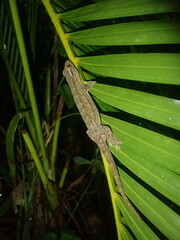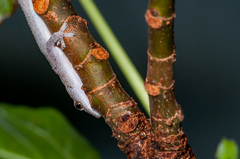Gekkota: taxon details and analytics
- Domain
- Kingdom
- Animalia
- Phylum
- Chordata
- Class
- Reptilia
- Order
- Squamata
- Family
- Genus
- Species
- Scientific Name
- Gekkota
Summary description from Wikipedia:
Gekkota
Geckos are small, mostly carnivorous lizards that have a wide distribution, found on every continent except Antarctica. Belonging to the infraorder Gekkota, geckos are found in warm climates. They range from 1.6 to 60 centimetres (0.6 to 23.6 inches).
Geckos are unique among lizards for their vocalisations, which differ from species to species. Most geckos in the family Gekkonidae use chirping or clicking sounds in their social interactions. Tokay geckos (Gekko gecko) are known for their loud mating calls, and some other species are capable of making hissing noises when alarmed or threatened. They are the most species-rich group of lizards, with about 1,500 different species worldwide.
All geckos, except species in the family Eublepharidae, lack eyelids; instead, the outer surface of the eyeball has a transparent membrane, the brille. They have a fixed lens within each iris that enlarges in darkness to let in more light. Since they cannot blink, species without eyelids generally lick their own brilles when they need to clear them of dust and dirt, in order to keep them clean and moist.
Unlike most lizards, geckos are usually nocturnal and have excellent night vision; their colour vision in low light is 350 times more sensitive than human eyes. The nocturnal geckos evolved from diurnal species, which had lost the rod cells from their eyes. The gecko eye, therefore, modified its cone cells that increased in size into different types, both single and double. Three different photo-pigments have been retained, and are sensitive to ultraviolet, blue, and green. They also use a multifocal optical system that allows them to generate a sharp image for at least two different depths. While most gecko species are nocturnal, some species are diurnal and active during the day, which have evolved multiple times independently.
Many species are well known for their specialised toe pads, which enable them to grab and climb onto smooth and vertical surfaces, and even cross indoor ceilings with ease. Geckos are well known to people who live in warm regions of the world, where several species make their home inside human habitations. These, for example the house gecko, become part of the indoor menagerie and are often welcomed, as they feed on insect pests including moths and mosquitoes. Like most lizards, geckos can defensively shed their tail; the predator may attack the wriggling tail, allowing the gecko to escape.
The largest species, Gigarcanum delcourti, is only known from a single, stuffed specimen probably collected in the 19th century found in the basement of the Natural History Museum of Marseille in Marseille, France. This gecko was 600 millimetres (24 inches) long, and was likely endemic to New Caledonia, where it lived in native forests. The smallest gecko, the Jaragua sphaero, is a mere 16 millimetres (0.63 inches) long and was discovered in 2001 on a small island off the coast of Hispaniola.
...Gekkota in languages:
- Bulgarian
- Геконови
- Chinese
- 壁虎下目
- Croatian
- Macaklini
- Dutch
- Gekko-achtigen
- English
- Gekkotans
- English
- Geckos
- Georgian
- გეკონისებრნი
- German
- Geckoartige
- Hebrew
- דמויי שממית
- Hungarian
- Gekkófélék
- Italian
- Gechi
- Japanese
- ヤモリ下目
- Korean
- 도마뱀부치하목
- Modern Greek
- Γκεκότα
- Occitan
- Tarenta
- Polish
- Gekonowe
- Portuguese
- Gecos e afins
- Russian
- Гекконы
- Russian
- Гекконообразные
- Sinhala
- හූනන්
- Thai
- จิ้งจก ตุ๊กแก ฯลฯ
- Vietnamese
- Họ Tắc kè
Images from inaturalist.org observations:
We recommend you sign up for this excellent, free service.
Parent Taxon
Sibling Taxa
- Agamidae
- Alopoglossidae
- Anguidae
- Anolidae
- Chamaeleonidae
- Cordylidae
- Corytophanidae
- Crotaphytidae
- Dibamidae
- Diploglossidae
- Gekkota
- Gerrhosauridae
- Gymnophthalmidae
- Helodermatidae
- Hoplocercidae
- Iguanidae
- Lacertidae
- Lanthanotidae
- Leiocephalidae
- Leiosauridae
- Liolaemidae
- Opluridae
- Phrynosomatidae
- Polychrotidae
- Scincidae
- Shinisauridae
- Teiidae
- Tropiduridae
- Varanidae
- Xantusiidae
- Xenosauridae
Child Taxa
Top Observation Places
- Mandaluyong City
- Guatemala City
- Tung Chung
- Nāgercoil
- Noida
- Hollywood
- Benito Juarez
- Colonia del Valle
- Brisbane
- San José
- Neihu
- Macau
- Playa del Carmen
- Wellington
- Thāne
- Panamá
- Las Cumbres
- Singapore
- Woodlands
- Queenstown Estate
- Shenzhen
- Hong Kong
- Kowloon
- Victoria
- Sha Tin
- Tseung Kwan O
- Kwai Chung
- Tsuen Wan
- Tai Po
- Fanling
- Ma On Shan
- Tsing Yi Town
- Yuen Long Kau Hui
- Pok Fu Lam































































































































































